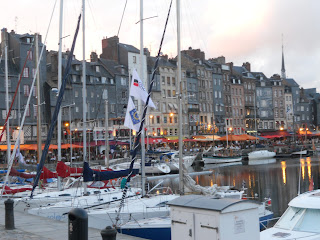Well quite a lot actually. An area rich in history, beautiful coastal and pastoral landscapes and gut busting cuisine was just waiting to be explored.
We commenced are journey a mere hour from Paris taking in the extraordinary view of the Seine’s white cliffs, as well as the crumbling ruins of Chateau Galliard, at Les Andelys. A lovely stop off on the way to Rouen with its elegant old city. The gothic spires of the Cathedral, the abbey and the church rise effortlessly above the rooftops of the half timbered houses making navigating the cobbled streets a breeze.
We rounded off a lovely day at a traditional Norman eatery chowing down on escagrots and braised lamb stew to warm our bones!!!
With coastal withdrawal symptoms the pretty little fishing villages of Hornfleur, Deauville and Trouville were next on our hit list. Hornfleur’s charming quayside lined with restaurants offering all manner of fresh seaside crustaceans provided the perfect spot to while away an evening watching the sailors fill their pleasure boats and head out for an evening cruise.
Our day trip to Deauville coincided with the American film festival which had taken over the chic, designer shop lined streets of this pretty little place. To be honest, the amount of stars and stripes on display, you would be forgiven for thinking you had been transported to a different continent. The festival is the lesser known little sister of the main event in Cannes. Nevertheless the seafront was lined with a red carpet and the ardent fans were setting up camp alongside the paparazzi to try and catch a glimpse of the stars as they strutted their stuff later that evening. We had neither the time nor inclination to hand around all day in the hope that somebody famous might show up!
The 80km of beaches that stretch along Normandy’s coastline still bear the code names they were given during operation overlord on 6th June 1944. Sword, Juno, Gold, Omaha and Utah were the sights of the largest military operation in history, where an armada of over 6000 sea-craft, joined forces with the air forces and tens of thousands of allied troops from Britain, the USA and Canada mounted a surprise attack to defeat the Germans and give back control of France to the french. This operation will be forever known as the D Day landings.
A visit to the beaches is a truly moving experience. The whole area maintains an eerie, memorial like silence, not allowing you to forget the ultimate sacrifice paid by tens of thousands of men in order to preserve peace.
The museum at Arromanches provides the perfect start to a visit to the beaches. It explains the importance of and logistics behind the building of the pre-fabricated harbours code named ‘Mulberry Harbour’ the remains of which can been seen out of its windows.
The process was a truly impressive feet of engineering, never before attempted and completed on enemy soil, during a war right under the noses of the Germans! In short, to win the war it was not enough to simply send over a first wave of men and machinery. They needed to be supported with constant supplies of cargo, vehicles and troops. To do this a port was needed. The Germans knew this and as such all of the Normandy Ports were heavily guarded and defended to the death with orders to destroy the port rather than let it fall in to enemy hands. As such, the brainchild of Sir Winston Churchill, a temporary port was built by sinking old ships and dragging over 146 enormous cement cassions from England. Joined together with floating pontoons the harbour stood up to the ferocious seas with massive tidal ranges and enabled the allies to unload a staggering 2.5 million men, 4 million tonnes of equipment and 500,000 equipment. Astounding!
German gun emplacements still in situ
Mike as lookout
Our final day in Normandy was spent at perhaps its most famous attraction, Mont St Michel. A medieval Abbey surrounded by turrets and ramparts which whisk you back to the middle ages. It is not quite an island, connected to the mainland by a narrow causeway. (Although that will be replaced by a huge bridge by 2015 allowing the silt which has gradually built up to disappear transforming it back in to the Island that it ought to be). Although hammered with tourists, the charm of the winding streets that lead to the abbey and the uninterrupted views from the ramparts are not lost and the place a well worth a visit.












No comments:
Post a Comment